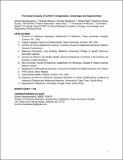Files in this item
The global inequity of COVID-19 diagnostics : challenges and opportunities
Item metadata
| dc.contributor.author | Narayanasamy, Shanti | |
| dc.contributor.author | Okware, Brenda | |
| dc.contributor.author | Muttamba, Winters | |
| dc.contributor.author | Patel, Kirtika | |
| dc.contributor.author | Duedu, Kwabena Obeng | |
| dc.contributor.author | Ravi, Nirmal | |
| dc.contributor.author | Ellermeier, Nathan | |
| dc.contributor.author | Shey, Muki | |
| dc.contributor.author | Woods, Christopher W | |
| dc.contributor.author | Sabiiti, Wilber | |
| dc.contributor.author | COVID-19 Clinical Research Coalition, Virology, Immunology, and Diagnostics Working Group | |
| dc.date.accessioned | 2022-09-21T10:30:17Z | |
| dc.date.available | 2022-09-21T10:30:17Z | |
| dc.date.issued | 2022-12-01 | |
| dc.identifier | 281394815 | |
| dc.identifier | 1c15305f-87cf-4c5f-95f1-1bbbdc82268e | |
| dc.identifier | 000865495200001 | |
| dc.identifier | 85142500438 | |
| dc.identifier.citation | Narayanasamy , S , Okware , B , Muttamba , W , Patel , K , Duedu , K O , Ravi , N , Ellermeier , N , Shey , M , Woods , C W , Sabiiti , W & COVID-19 Clinical Research Coalition, Virology, Immunology, and Diagnostics Working Group 2022 , ' The global inequity of COVID-19 diagnostics : challenges and opportunities ' , Journal of Epidemiology and Community Health , vol. 76 , no. 12 , pp. 972-975 . https://doi.org/10.1136/jech-2022-219333 | en |
| dc.identifier.issn | 0143-005X | |
| dc.identifier.other | ORCID: /0000-0002-4742-2791/work/120849886 | |
| dc.identifier.uri | https://hdl.handle.net/10023/26048 | |
| dc.description.abstract | Diagnostics for COVID-19 have advanced at an unprecedented pace over the last two years. Testing is a critical pillar of pandemic control, and is required for epidemiological tracking, treatment, and surveillance. Despite high quality SARS-CoV-2 viral diagnostic capability, there are vast global inequities in access. The Virology, Immunology, and Diagnostics Working Group(WG) of the COVID-19 Clinical Research Coalition (CRC) brings together experts in immunology, infectious diseases, and microbiology to advocate for equity-based COVID-19 research, prioritising solutions driven by communities in low-income and lower middle-income countries (LMICs).1 This commentary shares the unique perspective of the WG on the asymmetry in COVID-19 diagnostic access between low-income and high-income settings, the barriers to these disparities, and highlights opportunities to remedy these inequities. | |
| dc.format.extent | 4 | |
| dc.format.extent | 95701 | |
| dc.language.iso | eng | |
| dc.relation.ispartof | Journal of Epidemiology and Community Health | en |
| dc.subject | COVID-19 | en |
| dc.subject | HV Social pathology. Social and public welfare | en |
| dc.subject | RA0421 Public health. Hygiene. Preventive Medicine | en |
| dc.subject | T-DAS | en |
| dc.subject | SDG 3 - Good Health and Well-being | en |
| dc.subject | MCC | en |
| dc.subject.lcc | HV | en |
| dc.subject.lcc | RA0421 | en |
| dc.title | The global inequity of COVID-19 diagnostics : challenges and opportunities | en |
| dc.type | Journal article | en |
| dc.contributor.institution | University of St Andrews. Infection and Global Health Division | en |
| dc.contributor.institution | University of St Andrews. School of Medicine | en |
| dc.identifier.doi | https://doi.org/10.1136/jech-2022-219333 | |
| dc.description.status | Peer reviewed | en |
This item appears in the following Collection(s)
Items in the St Andrews Research Repository are protected by copyright, with all rights reserved, unless otherwise indicated.

